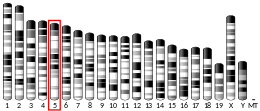SSC4D
Scavenger receptor cysteine rich family member with 4 domains is a protein that in humans is encoded by the SSC4D gene. [5]
| SSC4D | |||||||||||||||||||||||||
|---|---|---|---|---|---|---|---|---|---|---|---|---|---|---|---|---|---|---|---|---|---|---|---|---|---|
| Identifiers | |||||||||||||||||||||||||
| Aliases | SSC4D, S4D-SRCRB, SRCRB-S4D, SRCRB4D, scavenger receptor cysteine rich family member with 4 domains | ||||||||||||||||||||||||
| External IDs | OMIM: 607639 MGI: 1924709 HomoloGene: 34137 GeneCards: SSC4D | ||||||||||||||||||||||||
| |||||||||||||||||||||||||
| |||||||||||||||||||||||||
| |||||||||||||||||||||||||
| Orthologs | |||||||||||||||||||||||||
| Species | Human | Mouse | |||||||||||||||||||||||
| Entrez | |||||||||||||||||||||||||
| Ensembl | |||||||||||||||||||||||||
| UniProt | |||||||||||||||||||||||||
| RefSeq (mRNA) | |||||||||||||||||||||||||
| RefSeq (protein) | |||||||||||||||||||||||||
| Location (UCSC) | Chr 7: 76.39 – 76.41 Mb | Chr 5: 135.96 – 135.97 Mb | |||||||||||||||||||||||
| PubMed search | [3] | [4] | |||||||||||||||||||||||
| Wikidata | |||||||||||||||||||||||||
| |||||||||||||||||||||||||
Function
The scavenger receptor cysteine-rich (SRCR) superfamily is an ancient and highly conserved group of cell surface and/or secreted proteins, some of which are involved in the development of the immune system and the regulation of both innate and adaptive immune responses. Group B SRCR domains usually contain 8 regularly spaced cysteines that give rise to a well-defined intradomain disulfide-bond pattern.
References
- GRCh38: Ensembl release 89: ENSG00000146700 - Ensembl, May 2017
- GRCm38: Ensembl release 89: ENSMUSG00000029699 - Ensembl, May 2017
- "Human PubMed Reference:". National Center for Biotechnology Information, U.S. National Library of Medicine.
- "Mouse PubMed Reference:". National Center for Biotechnology Information, U.S. National Library of Medicine.
- "Entrez Gene: Scavenger receptor cysteine rich family member with 4 domains". Retrieved 2016-09-05.
Further reading
- Padilla O, Pujana MA, López-de la Iglesia A, Gimferrer I, Arman M, Vilà JM, Places L, Vives J, Estivill X, Lozano F (2002). "Cloning of S4D-SRCRB, a new soluble member of the group B scavenger receptor cysteine-rich family (SRCR-SF) mapping to human chromosome 7q11.23". Immunogenetics. 54 (9): 621–34. doi:10.1007/s00251-002-0507-z. PMID 12466895.
This article incorporates text from the United States National Library of Medicine, which is in the public domain.
This article is issued from Wikipedia. The text is licensed under Creative Commons - Attribution - Sharealike. Additional terms may apply for the media files.



